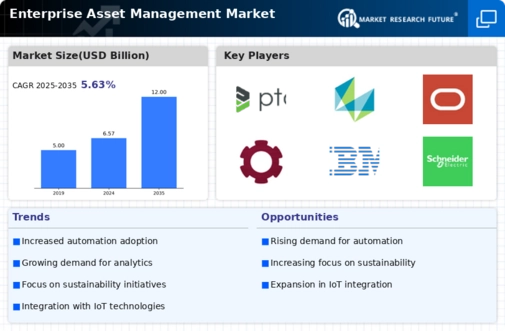Market Analysis
In-depth Analysis of Enterprise Asset Management Market Industry Landscape
The Enterprise Asset Management (EAM) market is characterized by dynamic forces shaping its growth and evolution, driven by the intersection of technological advancements, changing business requirements, and a focus on operational efficiency. One key dynamic is the increasing adoption of Internet of Things (IoT) devices and sensors. The integration of IoT into EAM allows organizations to collect real-time data from assets, enabling proactive maintenance and data-driven decision-making. This dynamic reflects the industry's recognition of IoT as a transformative technology in enhancing asset performance, reducing downtime, and optimizing maintenance practices.
Regulatory compliance is a significant force shaping the dynamics of the EAM market. Industries such as manufacturing, energy, and healthcare face stringent regulations governing asset management and maintenance. EAM systems play a crucial role in ensuring compliance by providing centralized tracking, documentation, and reporting capabilities. The dynamic regulatory landscape requires EAM solutions to be adaptable and scalable, reflecting the industry's commitment to meeting compliance standards and minimizing regulatory risks.
The transition to cloud-based EAM solutions is a notable dynamic in the market. Organizations are increasingly adopting cloud-based systems for asset management, offering benefits such as scalability, accessibility, and cost-effectiveness. Cloud-based EAM allows for real-time collaboration, remote access, and simplified software updates. This dynamic aligns with the broader trend of digital transformation, reflecting the industry's focus on leveraging cloud technologies to enhance flexibility and efficiency in asset management practices.
Predictive maintenance is a transformative dynamic in the EAM market. Leveraging data analytics and machine learning, organizations can predict equipment failures and schedule maintenance activities before issues arise. This shift from reactive to proactive maintenance enhances asset reliability, reduces downtime, and lowers operational costs. The adoption of predictive maintenance reflects the industry's commitment to optimizing asset performance and minimizing disruptions through advanced analytics and automation.
The convergence of EAM with other enterprise software solutions is shaping the dynamics of the market. Integration with Enterprise Resource Planning (ERP), Customer Relationship Management (CRM), and other business systems provides a holistic view of organizational operations. This dynamic reflects the industry's recognition of the interconnected nature of business processes and the need for seamless data flow between different functions, enhancing overall organizational efficiency.
Mobile EAM solutions are becoming increasingly prevalent, representing a dynamic response to the changing nature of work. Mobile applications enable field technicians and maintenance teams to access EAM systems on smartphones and tablets, facilitating real-time updates, work orders, and asset information. This dynamic aligns with the industry's commitment to enhancing workforce mobility, productivity, and responsiveness to on-the-ground asset management needs.
The emphasis on sustainability and environmental considerations is influencing the dynamics of the EAM market. Organizations are integrating sustainability metrics into their asset management practices, tracking energy consumption, emissions, and other environmental impacts. EAM systems are evolving to include features that support sustainable asset management practices, reflecting the industry's commitment to corporate social responsibility and environmental stewardship.
Data security and privacy considerations are emerging as critical dynamics in the EAM market. As organizations accumulate and analyze vast amounts of sensitive data related to assets, ensuring the security and privacy of this information becomes paramount. EAM solutions need robust cybersecurity measures and compliance frameworks to address these concerns. This dynamic underscores the industry's recognition of the importance of securing asset data in the age of digital asset management.
The talent gap in asset management expertise is a notable challenge influencing the dynamics of the EAM market. While the demand for skilled professionals with expertise in EAM systems is growing, there is a shortage of qualified talent. Organizations are addressing this challenge through training programs, partnerships with educational institutions, and collaboration with EAM solution providers. This dynamic reflects the industry's proactive efforts to bridge the talent gap and cultivate a workforce capable of effectively utilizing EAM technologies.

















Leave a Comment